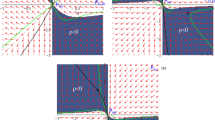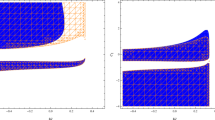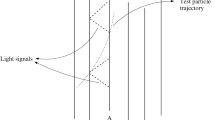Abstract
Simple exact solutions presented here describe universes whose spatial geometries are asymptotically homogeneous and isotropic near the initial singularity but whose evolution proceeds under the influence of primordial magnetic fields. In all these “deformed” Friedmann models (spatially flat, open or closed), the initial magnetic fields are concentrated near some axis of symmetry and their lines are the circles given by the lines of the azimuthal coordinate φ. Caused by the expansion of the universe, the time dependence of a magnetic field induces (in accordance with the Faraday law) the emergence of source-free electric fields. In comparison with the Friedmann models, the cosmological expansion proceeds with acceleration in the spatial directions across the magnetic field and with deceleration along the magnetic lines, so that in the flat and open models, in fluid comoving coordinates, the lengths of φ-circles of sufficiently large radius or for sufficiently late times decrease and vanish as t → ∞. This means that in the flat and open models we have a partial dynamical closure of space-time at large distances from the symmetry axis, i.e., from the regions where the electromagnetic fields in our solutions are concentrated. To get simple exact solutions of the Einstein-Maxwell and perfect fluid equations, we assume a rather exotic stiff matter equation of state ɛ = p for the perfect fluid (which supports isotropic and homogeneous “background” Friedmann geometries). However, it seems reasonable to expect that similar effects might occur in the mutual dynamics of geometry and strong electromagnetic fields in universes with more realistic matter equations of state.
Similar content being viewed by others
References
A. G. Doroshkevich, “Model of a universe with a uniform magnetic field,” Astrofizika 1, 255–266 (1965) [Astrophys. 1, 138–142 (1965)].
I. S. Shikin, “A uniform anisotropic cosmological model with a magnetic field,” Dokl. Akad. Nauk SSSR 171(1), 73–76 (1966) [Sov. Phys., Dokl. 11, 944–946 (1966)].
K. C. Jacobs, “Cosmologies of Bianchi type I with a uniform magnetic field,” Astrophys. J. 155, 379–391 (1969).
I. S. Shikin, “Gravitational fields with groups of motions on two-dimensional transitivity hypersurfaces in a model with matter and a magnetic field,” Commun. Math. Phys. 26, 24–38 (1972).
U. K. De, “Bianchi type I cosmological models with pure magnetic field,” Acta Phys. Pol. B 6, 341–346 (1975).
A. Krasiński, Inhomogeneous Cosmological Models (Cambridge Univ. Press, Cambridge, 1997).
V. A. Belinskii, “One-soliton cosmological waves,” Zh. Eksp. Teor. Fiz. 77(4), 1239–1254 (1979) [Sov. Phys., JETP 50, 623–631 (1979)].
V. A. Belinskii and V. E. Zakharov, “Integration of the Einstein equations by means of the inverse scattering problem technique and construction of exact soliton solutions,” Zh. Eksp. Teor. Fiz. 75(6), 1955–1971 (1978) [Sov. Phys., JETP 48, 985–994 (1978)].
G. A. Alekseev, “N-soliton solutions of Einstein-Maxwell equations,” Pis’ma Zh. Eksp. Teor. Fiz. 32(4), 301–303 (1980) [JETP Lett. 32, 277–279 (1980)].
G. A. Alekseev, “The method of the inverse problem of scattering and the singular integral equations for interacting massless fields,” Dokl. Akad. Nauk SSSR 283(3), 577–582 (1985) [Sov. Phys., Dokl. 30, 565–568 (1985)].
G. A. Alekseev, “Exact solutions in the general theory of relativity,” Tr. Mat. Inst. im. V.A. Steklova, Akad. Nauk SSSR 176, 211–258 (1987) [Proc. Steklov Inst. Math. 176, 215–262 (1988)].
G. A. Alekseev, “Thirty years of studies of integrable reductions of Einstein’s field equations,” in Proc. Twelfth Marcel Grossmann Meeting on General Relativity, Ed. by T. Damour and R. T. Jantzen (World Scientific, Singapore, 2012), Part A, pp. 645–666; arXiv: 1011.3846v1 [gr-qc].
G. Neugebauer and D. Kramer, “Eine Methode zur Konstruktion stationärer Einstein-Maxwell-Felder,” Ann. Phys. 479, 62–71 (1969).
W. Israel and G. A. Wilson, “A class of stationary electromagnetic vacuum fields,” J. Math. Phys. 13(6), 865–867 (1972).
W. Kinnersley, “Generation of stationary Einstein-Maxwell fields,” J. Math. Phys. 14(5), 651–653 (1973).
B. K. Harrison, “New solutions of the Einstein-Maxwell equations from old,” J. Math. Phys. 9(11), 1744–1752 (1968).
Author information
Authors and Affiliations
Corresponding author
Additional information
Published in Russian in Trudy Matematicheskogo Instituta imeni V.A. Steklova, 2013, Vol. 281, pp. 137–148.
Rights and permissions
About this article
Cite this article
Alekseev, G.A. Influence of electromagnetic fields on the evolution of initially homogeneous and isotropic universe. Proc. Steklov Inst. Math. 281, 129–139 (2013). https://doi.org/10.1134/S0081543813040111
Received:
Published:
Issue Date:
DOI: https://doi.org/10.1134/S0081543813040111




